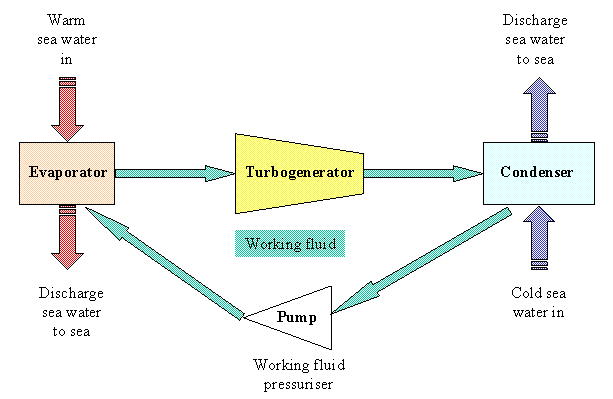
Three quarters of the earths surface is occupied by oceans, an enormous source of
non polluting, inexhaustible energy. Except for the tidal power plant of La Rance, the amount of electricity being exploited from this great resource is less than 100 mW.
OTEC is different than other renewable energy systems as it does not only focus on the production of electricity however also provides fresh water as a by product.
OTEC systems use natural temperature differences in tropical surface and deep-ocean
water to generate power.
This system is less known that other types of renewable energy
conversion system and thus deserves some explanation.
Basically there are two types of OTEC system:
Closed cycle and Open cycle.
There is also the Hybrid cycle, which is a combination of both open and closed cycle
but which is not tested yet.
OTEC system uses the Carnot cycle to generate electricity at a very low efficiency.
Theoretically this efficiency is around 7% but practically it hardly reaches 3%.
In any case, OTEC system produces electricity but in the case of Open and Hybrid cycle, it can as well produce fresh water as a by-product.
As mentioned previously, OTEC uses the difference of temperature between the surface water and the deep water. It starts to produce a net power when this difference is equal or more than 20 degree C. The suitable locations for OTEC in the world are thus limited.
(table of suitable locations for OTEC in the world matching with location of offshore platforms).| Geographical area | Mainland | Island |
|---|---|---|
| Americas | Mexico, Brazil, Venezuela, United States | Trinidad & Tobago |
| Africa | Nigeria, Congo, Gabon, Zaire, Angola, Cameroon | . |
| Indian/Pacific Ocean | Malaysia, Australia, Japan, Brunei | Indonesia, Philippines |
Benefits
Because the system needs to pump the cold water from very deep in the ocean (>800 m), it removes many nutrients from the bottom to the surface of the ocean. These nutrients are appreciated by many marine species therefore an OTEC system can thus be used as mariculture centre.
It also creates potential to reduce atmospheric CO2 through the combined effect of biological growth and minerals addition.
The release of carbon dioxide from deaeration before the flash evaporator would be in the worst case scenario one-fifteenth that released by oil in a plant for equivalent electrical output.Drawbacks
The large flows of hot and cold water might, conceivably, modify local or even global weather patterns, although the evidence is scarce.
The source of deep cold water must be within a few kilometres of the plant size to keep the cost of the expensive cold-water pipe to a minimum.
OTEC plants need a very high capital cost. Experts are speaking about $40,000,000.00 for a 10 MW land based plant.
According to Patrick Takahashi and Andrew Trenka, the cost of electricity produced shoud be between 0.08 and 0.27 $/kWh but some companies claim to be able to reduce this cost by using more efficient processes.
The cost of electricity can be reduced by the cost of the fresh water as a by-product.
The plant size of a 10 MW OTEC system could be compatible with the size of an average platform. The platform will not experience any more loading contraints than originally experienced from the existing topside.
The obvious problem is that this technology is not available today or even tomorrow but at a longer term (15 years).
The development of OTEC is certainly offshore on floatable platforms. Using a fixed offshore platform could be a step between a land based plant and a floatable platform.